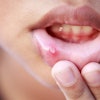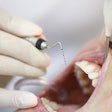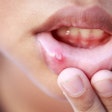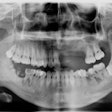
Spring is a gorgeous time of year. The days are bright, sunny, and warm but not too hot. Yet many people suffer from seasonal allergies that make springtime miserable. From sneezing to runny noses and watery eyes, the joy of spring is often overshadowed by the tree and grass pollen that permeates the air. Not only do springtime allergy sufferers exhibit symptoms during these difficult times, but patients often complain of symptoms year-round due to a variety of triggers. What should dental professionals know to assist our patients who suffer from allergic rhinitis?
 Ann-Marie C. DePalma, CDA, RDH, MEd.
Ann-Marie C. DePalma, CDA, RDH, MEd.
According to the Mayo Clinic, in the simplest terms, allergies occur when an individual's immune system reacts to a foreign substance, such as pollen, dust, pet dander, or food, that doesn't cause a reaction in most people. The immune system produces antibodies that identify the substance as harmful when it is not.
These antibodies trigger an immune response that causes inflammation and the release of histamine. In severe cases, allergies can cause a life-threatening reaction, anaphylaxis. Dental teams should review their emergency medical protocols annually to be prepared for a patient's allergic reaction including anaphylaxis.
Springtime allergies, allergic rhinitis, or hay fever, are caused by the reaction of the offending substance binding with the antibody, immunoglobulin E (IgE). When this reaction occurs, histamine is released to help the body defend itself against the "attacker." This histamine release results in a runny nose, congestion, sneezing, eye, and other symptoms associated with seasonal allergies.
Most patients who suffer from seasonal allergies rely on over-the-counter medications (OTC) or limit their exposure to the offenders. Keeping windows closed during high pollen days, showering after being outdoors, and washing bedding frequently are often suggested ways of reducing symptoms.
OTC or prescription corticosteroid nasal sprays help reduce nasal inflammation if the patient can tolerate nasal sprays. Saline and xylitol sprays are also helpful. Botox has even been recommended for short-term relief.
For long-term relief, subcutaneous immunotherapy or allergy shots, have long been the standard for reducing symptoms in patients. Injections of the offending substance (allergen) are given over a period to help lessen or stop the allergic reaction.
These shots are given over a three- to five-year period and may or may not be covered by third-party payers. With each injection, the dose of the allergen is increased so that the immune system learns to not react to the allergen, allowing symptoms to improve over time. Patients often find relief, but it can be time-consuming and expensive.
Several other types of immunotherapy have recently been promoted. These include rapid immunotherapy/ultrasound-guided intralymphatic immunotherapy, sublingual immunotherapy, and oral mucosal immunotherapy.
Ultrasound-guided intralymphatic immunotherapy or rapid immunotherapy uses a purified allergen extract injected via ultrasound guidance into lymph nodes. Inguinal (groin) lymph nodes are used. A total of three to four injections are given every three to four weeks over eight to 12 weeks.
Similar to allergy shots, patients remain in the office for a short observation period to ensure there are no untoward side effects. As with any injection, mild side effects, such as redness, swelling, or mild discomfort, at the injection site can be experienced.
Since the therapy is not approved by the U.S. Food and Drug Administration (FDA) and therefore not covered by third-party payers, patients are responsible for the costs, which can average over $3,000! Intralymphatic immunotherapy currently is being used for adults, but studies on children are pending, with environmental allergens being the current treatment recommendations. Patients experience relief much quicker through intralymphatic immunotherapy versus subcutaneous injections.
Sublingual immunotherapy (SLIT) consists of tablets or drops administered under a patient’s tongue. Small amounts of the allergen are given to the patient to gradually improve the immune system's response. Tablets are approved by the FDA, while drops are not. Therefore, the drops are not covered by third-party payers. The drops, however, can be customized and blended for each patient's individual environmental allergy needs. Tablets are only used for specific allergens, including ragweed, some grasses, and dust mites.
SLIT is used for both children and adults, although patients who are taking beta blockers and some asthma patients are not candidates. Similar to allergy shots, patients can be on sublingual therapy for three to five years, with some patients using drops or tablets year-round, while others only use sublingual therapy during flare times. Patients may experience mild irritation to the oral cavity, intestinal discomfort, or other mild symptoms. Depending on drops or tablets, the cost averages from $1,000 to several thousand per year.
Oral mucosal immunotherapy (OMIT) is of interest to dental professionals. A specially formulated toothpaste (that's right, a toothpaste) has been shown to improve both environmental and food allergies in patients! Like other immunotherapies, the toothpaste is specially formulated for the patient's allergic needs yet provides a higher rate of compliance.
The oral cavity has a high abundance of mast cells and Langerhans cells, which are involved in the immune response. Patients are advised to use the toothpaste once per day (usually at bedtime) for at least two minutes and rinse thoroughly. Two minutes of brushing time is not only beneficial for biofilm removal, but it also allows for the mucous membranes to absorb the immunotherapeutic agents. Over a period of weeks (not years), the body begins to build a resistance to the allergen.
Convenience and compliance are the largest benefits of OMIT along with reduced treatment risks, an avoidance of injections while treating multiple allergens at the same time with minimal side effects. The overall cost is much less than other forms of therapy, but the author was unable to research an estimate of toothpaste cost, although one distributor cited that a tube lasts 12 weeks.
Additionally, a small study released in November 2023 from the American College of Allergy, Asthma and Immunology cited that OMIT toothpaste may be beneficial in overcoming food allergies, particularly peanut allergies in adults. More research is needed, especially in children. OMIT is several years away from actual patient use.
As oral immunotherapy becomes a strategy for a variety of allergy patients, the dentistry-medicine connection will become stronger. Stay tuned!
Editor's Note: References available upon request.
Ann-Marie C. DePalma, CDA, RDH, MEd, is a graduate of the Forsyth School for Dental Hygienists, Northeastern University, and the University of Massachusetts Boston. She is a fellow of the Association of Dental Implant Auxiliaries, a fellow of the American Academy of Dental Hygiene, a continuous member and fellow of the American Dental Hygienists' Association as well as a lifetime member of the American Association of Dental Office Management. She is the 2017 Esther Wilkins Distinguished Alumni of Forsyth Award recipient.
The comments and observations expressed herein do not necessarily reflect the opinions of DrBicuspid.com, nor should they be construed as an endorsement or admonishment of any particular idea, vendor, or organization.



















